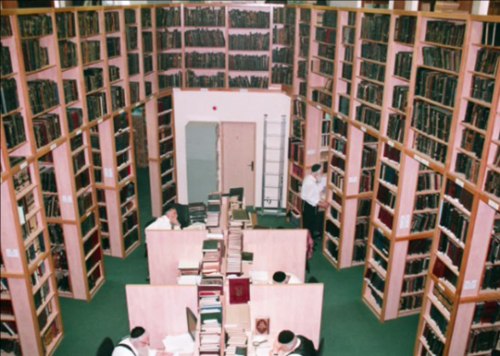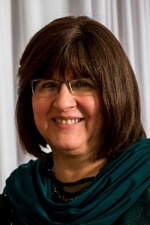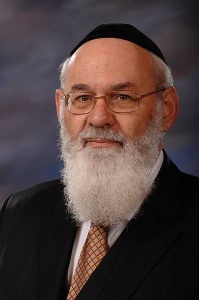
By Toby Klein Greenwald


JERUSALEM–The gentle autumn wind foreshadows the holiday season as I locate a modest doorway on a tree-lined Jerusalem street, the side entrance to the elegant 90-year-old Yeshurun Synagogue. It leads to Yad HaRav Herzog, a research center which hosts, among other projects, the venture that is possibly the most momentous historical milestone in the reference history of Torah scholarship.
This is the home of the Talmudic Encyclopedia (Encyclopedia Talmudit).
Today’s two-story library houses thousands of books and manuscripts, but it is by no means dark or musty, rather a soft light filters in through the high windows. From its top gallery I get a long shot of Rav Zalman Nechemia Goldberg in his modest side cubicle, the editor-in-chief of the encyclopedia, who is also the Chief Justice emeritus of the Rabbinical High Court in Jerusalem.
The importance and popularity of the Talmudic Encyclopedia is in its accessibility not only to scholars, but to anyone who wants to understand certain phrases or concepts or ideas within the vast world of Torah knowledge or Judaism, and who does not have the opportunity or ability to wade through thousands of tomes of recorded Jewish scholarship. This, combined with the reliability, accuracy and condensed style is unparalleled in the halakhic literature.
The history of the Talmudic Encyclopedia parallels the history of the renewal of Jewish life in the Holy Land. Toward the second half of World War II, in1942, Rabbi Meir Berlin (Bar-Ilan), the son of the Netziv (Rabbi Naftali Zvi Yehuda Berlin) of Volozhin, envisioned assembling all of the Torah texts written and transmitted from the time of Revelation at Sinai to the present day, primarily for fear of losing the Torah together with the Jews in the Holocaust.
Professor Meir Bar Ilan, grandson and namesake of the project’s visionary, notes in a paper he wrote for Bar Ilan University, “Despite the name ‘Talmudic,’ this encyclopedia is not limited to the Talmud, but deals with and examines in alphabetical order… all aspects of Jewish Law, from Written and Oral Law to modern legal responsa dealing with electricity on Shabbat, etc. In short: a data base of enormous importance to anyone interested in studying Jewish Law in depth…”
Rav Berlin called on the services of Rabbi Shlomo Yosef Zevin, one of the greatest scholars of that generation, and had the phenomenal ability to summarize and organize complicated material into a form that would be easily understood. It was Rav Zevin who, in the beginning, determined which would be the more than two thousand entries, from aleph through taf, that would comprise the Talmudic Encyclopedia. This is the same list followed today. He also decided on the principles of the writing style and the extent of comprehensiveness. He was joined by some of the most erudite scholars alive, among them: Rav Yona Mertzbach, Rav Alter Hilewitz, Rav Binyamin Zvi Yehuda Rabinowitz-Teomim, and Rav Shimon Strelitz. The first volume of the Talmudic Encyclopedia was published in the year 1947 and contained over 200 entries. To date, 33 volumes have been published, and the number will reach about 70 when the project is completed.
The Talmudic Encyclopedia has garnered the praise of Ashkenazic, Sephardic and Hassidic rabbinic scholars from across the spectrum, including Rav Moshe Feinstein, Rav Shlomo Zalman Auerbach, Rav Ovadia Yosef, Rav Avraham Shapira, Rav Yehezkel Abramsky, the Novominsker, Belzer and Lubavitcher Rebbes and others.
Rav Zevin passed away in the year 1978. His place as the editor-in-chief was taken by Rav Avraham Farbstein, Rosh Yeshiva of Yeshivat Chevron in Jerusalem. Administrative management was in the hands of Rav Yehoshua Hutner. From the inception of the Talmudic Encyclopedia, more than one hundred rabbis and researchers have been involved in it.
In 2006, Rabbi Professor Avraham Steinberg accepted the position of head of the Editorial Board of the Talmudic Encyclopedia and director of Yad Harav Herzog. I interviewed him with a sense of awe; a brilliant rabbinic scholar, scientist and bio-ethicist, he is a legend in his time, yet is warm and personable. He is spearheading the development and completion of the Talmudic Encyclopedia in the 21st century.
Born in a displaced persons camp after WWII, Professor Steinberg immigrated with his parents as an infant to Israel in 1949, studied at Yeshivat Mercaz Harav and Hebrew University-Hadassah Medical School and served as a medical officer in the Israeli Air Force. He also trained in Pediatric Neurology at the Albert Einstein College of Medicine & Montefiore Hospital Medical Center, Bronx, New York.
Today he is a Senior Pediatric Neurologist and Director of the Medical Ethics Unit at Shaare Zedek Medical Center and a world recognized expert in Medical-Halakhic Research, on which he has lectured and published widely. He is co-chairman of the Israeli National Council on Bioethics. His major, groundbreaking work is the 7-volume “Encyclopedia Hilchatit Refuit” (in Hebrew) for which he received the Israel Prize in 1999. He has served as an adviser on medical ethics issues to the Knesset and to the Chief Rabbinate of Israel. He also has been involved in halakhic aspects of modern medical issues with the most prominent Rabbinic authorities, particularly with Rabbi S.Z. Auerbach zt”l, Rabbi Y.S. Eliashiv zt”l and Rabbi E.Y. Waldenberg zt”l.
Professor Steinberg has propelled the Talmudic Encyclopedia’s publication forward, in its technological capabilities and its research and writing methodology. It was a major challenge to maintain the high quality of the Encyclopedia, while limiting it to a reasonable amount of material, and speeding up the publication.
The speed with which the project is moving forward is partly stimulated by the fact that, recently, Mr. Dov Friedberg from Toronto, Canada has generously agreed to make a substantial contribution to the Talmudic Encyclopedia with the aim of completing the monumental work in ten years. The project directors hope that others in the Jewish world, like Friedberg, will recognize the significance of having their family names, or those of their loved ones, connected with this momentous project.
Since Professor Steinberg took over the leadership, they began to publish one volume a year, and last year they published two volumes in one year. In the coming years the objective is to publish three to four volumes annually in order to complete the entire project by the year 2024.
Q: Professor Steinberg, what is your personal motivation for being involved in this project?
A: “I have been using the Talmudic Encyclopedia for many years for my work. I think it is one of the most important works in our generation, and perhaps beyond. It is a work that will remain with us forever, that has no competitor, nor is one expected to emerge. Its uniqueness is in its breadth, its exactitude, its clarity of style, and especially its credibility and trustworthiness, thanks to the meticulous methodology with which it is created, with ongoing internal critique, and a team of outstanding scholars.
“I saw this as an opportunity to promote it and to bring it to completion, so in spite of the fact that I have many other projects in which I’m involved, and this demands a sacrifice of my personal interests, it is so important that I thought if I can be of help and it can be beneficial, I’ll do it.
“I don’t regret that decision. I’ve been here already eight years and we’re pushing it and it’s going well, but there are difficulties — primarily financial. ”
Q: What is planned for the Encyclopedia’s online presence?
A: “All the volumes will be accessible eventually online. There will ultimately be about 70 volumes and for most people the access will be via the internet.”
Q: Has that process begun yet
A: “No, it’s a question of money. Our first priority is to complete it, which we undertook to do in the next ten years. We have made plans regarding how many volumes we’ll complete every year, how many researchers we need…We are building our reservoir of researchers with great care. Many people have knowledge but most people don’t know how to write, and what is unique is the writing. For example, one needs to be able to take the teshuva, responsa, of the Rashba, which is five pages long, and distill it into one line that will be concise, accurate and give the full understanding of it. Or sometimes one has to take a source and subdivide it into different parts of the entry.
“We’ve established a special beit midrash to teach how to write correctly and especially how to write for the Talmudic Encyclopedia, which by itself is a costly enterprise. This year we’ll probably finish three volumes and in the future, even more, three-four a year. ”
Q: Where do these researcher-writers come from?
A: “From yeshivot and kollels. The base line is that they know Shas, the Talmud, because we’re dealing with the entire Shas. Secondly, they should already have some experience in writing — perhaps they’ve written books or articles — so we can see how they express themselves. Only if we’re convinced that they know the material and know how to write in general, we evaluate if they know how to write specifically for our needs. Sometimes we discover a few who are naturally talented and who do not have to be taught everything from scratch.
“We recently added another 14 writers and after they have gone through our beit midrash training process, they will be accepted for a year. If they will prove themselves, they will stay. We aim to end up with 30 scholar-writers, not more. That will happen in the next two years or so. Once we’ve found the right people, the project will go quicker.”
Q: How many editors are there?
A: “Three. The chief editor is Rav Zalman Nechemia Goldberg, and the others are Rav Meir Shmuelevitz and Rav Saar Meisel. There are two or three more but they work only on their material so there is no need for another editor above them.
Q: Please tell us more about the online version.
A: “We want the Encyclopedia to be more interactive than it is now and that is only possible through the internet. An additional benefit to putting it online is that hopefully, when we finish the whole project, we can go back to the beginning and correct, add information, etc., and people can read the updated version.
“All of the offers we received for an online presence are very costly but the ideal is to have the Talmudic Encyclopedia on four levels.
“Level I of the online version will include entries that have not yet been written, that will be a format of Wikipedia, in which everyone can contribute freely and our editors will moderate it. Then we will go according to our planned order of volumes and alphabetically extract, from this Wikipedia, material that will go to our editor and he will consider it.
“Level II will be all the entries from aleph till where we are, at the time, which will be closed to editing by the public. People cannot touch anything in the original material, but they will be able to add comments and quotes. If we agree with what they’ve written, we will adapt the original. It will be free or partially free,
“Level III will be the Talmudic Micropedia, which will consist of condensed entries from the original, in a user-friendly style and format that will be targeted at the general population. The Micropedia [of which Professor Steinberg is the editor-in-chief – TKG] is being developed and written by different people, and it comes from a different budget. The writers take an entry, study it, decide what is less and more important, then cite sources. It will available to everyone. It will be extensive enough for readers who are seeking a first resource. It also includes added information which had been previously omitted for some reason. Rav Goldberg reviews it all to be sure everything is accurate.
“At Level IV, hopefully, we’ll be able to translate the Micropedia into different languages so it will be accessible to everyone.”
Q: Who are the researchers?
A” “Many types of talmidei chachamim work here – haredi, ‘hardal,’ religious nationalist… The average age span is 40-50 for the Talmudic Encyclopedia and early 30’s for the Micropedia.”
Q: Do you feel they are lacking in any way by not coming from academia?
A: “There are advantages to academic studies but there is nothing I would have done differently. Our researcher-writers have been very carefully selected; they are highly intelligent and learned.”
*
As I left my interview with Rabbi Steinberg, I thought of Rabbi Tarfon who said, “It is not incumbent upon you to complete the work, but neither are you at liberty to desist from it.” (Avot 2:21) It is deeply inspiring to witness a 72-year-old project, so greatly admired throughout the world of Jewish scholarship, progressing rapidly so that current and future generations will be able to more easily immerse themselves in the treasures of the Torah.
*
Greenwald is a freelance writer based in Jerusalem.
Pingback: Daily Reyd - Torah Musings